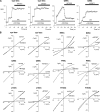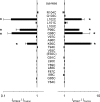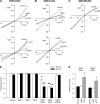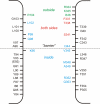Alignment of transmembrane regions in the cystic fibrosis transmembrane conductance regulator chloride channel pore
- PMID: 21746847
- PMCID: PMC3149817
- DOI: 10.1085/jgp.201110605
Alignment of transmembrane regions in the cystic fibrosis transmembrane conductance regulator chloride channel pore
Abstract
Different transmembrane (TM) α helices are known to line the pore of the cystic fibrosis TM conductance regulator (CFTR) Cl(-) channel. However, the relative alignment of these TMs in the three-dimensional structure of the pore is not known. We have used patch-clamp recording to investigate the accessibility of cytoplasmically applied cysteine-reactive reagents to cysteines introduced along the length of the pore-lining first TM (TM1) of a cysteine-less variant of CFTR. We find that methanethiosulfonate (MTS) reagents irreversibly modify cysteines substituted for TM1 residues K95, Q98, P99, and L102 when applied to the cytoplasmic side of open channels. Residues closer to the intracellular end of TM1 (Y84-T94) were not apparently modified by MTS reagents, suggesting that this part of TM1 does not line the pore. None of the internal MTS reagent-reactive cysteines was modified by extracellular [2-(trimethylammonium)ethyl] MTS. Only K95C, closest to the putative intracellular end of TM1, was apparently modified by intracellular [2-sulfonatoethyl] MTS before channel activation. Comparison of these results with recent work on CFTR-TM6 suggests a relative alignment of these two important TMs along the axis of the pore. This alignment was tested experimentally by formation of disulfide bridges between pairs of cysteines introduced into these two TMs. Currents carried by the double mutants K95C/I344C and Q98C/I344C, but not by the corresponding single-site mutants, were inhibited by the oxidizing agent copper(II)-o-phenanthroline. This inhibition was irreversible on washing but could be reversed by the reducing agent dithiothreitol, suggesting disulfide bond formation between the introduced cysteine side chains. These results allow us to develop a model of the relative positions, functional contributions, and alignment of two important TMs lining the CFTR pore. Such functional information is necessary to understand and interpret the three-dimensional structure of the pore.
Figures









Similar articles
-
Functional arrangement of the 12th transmembrane region in the CFTR chloride channel pore based on functional investigation of a cysteine-less CFTR variant.Pflugers Arch. 2011 Oct;462(4):559-71. doi: 10.1007/s00424-011-0998-2. Epub 2011 Jul 28. Pflugers Arch. 2011. PMID: 21796338
-
Changes in accessibility of cytoplasmic substances to the pore associated with activation of the cystic fibrosis transmembrane conductance regulator chloride channel.J Biol Chem. 2010 Oct 15;285(42):32126-40. doi: 10.1074/jbc.M110.113332. Epub 2010 Jul 30. J Biol Chem. 2010. PMID: 20675380 Free PMC article.
-
Cysteine scanning of CFTR's first transmembrane segment reveals its plausible roles in gating and permeation.Biophys J. 2013 Feb 19;104(4):786-97. doi: 10.1016/j.bpj.2012.12.048. Biophys J. 2013. PMID: 23442957 Free PMC article.
-
Mechanism of chloride permeation in the cystic fibrosis transmembrane conductance regulator chloride channel.Exp Physiol. 2006 Jan;91(1):123-9. doi: 10.1113/expphysiol.2005.031757. Epub 2005 Sep 12. Exp Physiol. 2006. PMID: 16157656 Review.
-
Cystic fibrosis transmembrane conductance regulator (CFTR): Making an ion channel out of an active transporter structure.Channels (Austin). 2018;12(1):284-290. doi: 10.1080/19336950.2018.1502585. Channels (Austin). 2018. PMID: 30152709 Free PMC article. Review.
Cited by
-
Positional effects of premature termination codons on the biochemical and biophysical properties of CFTR.J Physiol. 2020 Feb;598(3):517-541. doi: 10.1113/JP278418. Epub 2019 Nov 2. J Physiol. 2020. PMID: 31585024 Free PMC article.
-
Tuning of CFTR chloride channel function by location of positive charges within the pore.Biophys J. 2012 Oct 17;103(8):1719-26. doi: 10.1016/j.bpj.2012.09.020. Epub 2012 Oct 16. Biophys J. 2012. PMID: 23083715 Free PMC article.
-
Relative movements of transmembrane regions at the outer mouth of the cystic fibrosis transmembrane conductance regulator channel pore during channel gating.J Biol Chem. 2012 Sep 14;287(38):32136-46. doi: 10.1074/jbc.M112.385096. Epub 2012 Jul 26. J Biol Chem. 2012. PMID: 22843683 Free PMC article.
-
Alternating access to the transmembrane domain of the ATP-binding cassette protein cystic fibrosis transmembrane conductance regulator (ABCC7).J Biol Chem. 2012 Mar 23;287(13):10156-10165. doi: 10.1074/jbc.M112.342972. Epub 2012 Feb 1. J Biol Chem. 2012. PMID: 22303012 Free PMC article.
-
Functional organization of cytoplasmic portals controlling access to the cystic fibrosis transmembrane conductance regulator (CFTR) chloride channel pore.J Biol Chem. 2018 Apr 13;293(15):5649-5658. doi: 10.1074/jbc.RA117.001373. Epub 2018 Feb 23. J Biol Chem. 2018. PMID: 29475947 Free PMC article.
References
-
- Akabas M.H., Kaufmann C., Cook T.A., Archdeacon P. 1994. Amino acid residues lining the chloride channel of the cystic fibrosis transmembrane conductance regulator. J. Biol. Chem. 269:14865–14868 - PubMed
-
- Alexander C., Ivetac A., Liu X., Norimatsu Y., Serrano J.R., Landstrom A., Sansom M., Dawson D.C. 2009. Cystic fibrosis transmembrane conductance regulator: using differential reactivity toward channel-permeant and channel-impermeant thiol-reactive probes to test a molecular model for the pore. Biochemistry. 48:10078–10088 10.1021/bi901314c - DOI - PMC - PubMed
Publication types
MeSH terms
Substances
Grants and funding
LinkOut - more resources
Full Text Sources
Medical

